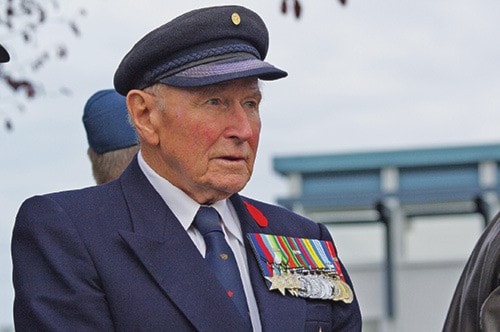There’s a chapter in Peter Godwin Chance’s book, A Sailor’s Life, that seems to stand out. It’s also a chapter in the Sidney veteran’s life and he retells it as if he was right there.
He was serving aboard the HMCS Skeena, an anti-submarine escort ship as the vessel’s navigator. By this time in his wartime naval career, Chance was a navigator, answering only to the ship’s captain. Overnight Oct. 24 and 25, 1944, the Skeena and the rest of the ships in their grouping, were caught in a heavy storm and were looking to anchor off the Iceland coast, near Reykjavik. Due to the poor material on the bottom of the harbour area (volcanic ash and such), Chance says he asked to be relieved of his duties if the captain was going to try to anchor there.
Instead, while respecting Chance’s opinion, the captain asked him to anchor the ship where he thought it best. He did so and for an hour, the ship didn’t drag. Yet, a worsening storm did not bode well for the vessel.
An hour or two later, Chance said he awoke to a “dreaded thumping” — the ship was grounding and the snow squalls had the Skeena listing to one side. The vessel was in trouble. Attempts to lower life boats failed in the weather and as the vessel listed even more — one was even destroyed.
The ship cracked, releasing oil, which was washed by the waves up onto the deck, making the situation all the more dangerous for the crew. One small group of sailors was swept away by the waves as they tried to leave the ship. In the end, 15 men were killed.
Most of the crew survived until morning by not leaving the vessel, Chance said, and were eventually evacuated.
That was one harrowing account of his experiences on the high seas during his service during the Second World War.
Chance found his way into the Canadian Navy via Ottawa. He was 18 years old and joined the Naval Volunteer Reserve prior to the end of 1939. By the new year, he went full-time into the Navy — a far cry from his youth, growing up as a figure skater who was a junior singles and pairs champion in 1938.
Chance went on to the Royal Naval College (U.K.) in Dartmouth in 1940, as part of a special entry group. He was there six months, eventually being posted to the HMS Mauritius, a colony class cruiser.
“It was pitch black at that time of year,” Chance said, recalling the night they first left Scapa Flow in Scotland in 1941. “It was at the same latitude as the entrance to Hudson’s Bay.”
That first trip sent the crew down to Gibraltar, Freetown, South Africa, the Cape of Good Hope and on to Durban, SA. From there, the vessel sailed to Sri Lanka and patrol in the Indian Ocean.
By 1942, Chance was taking his courses in submarine warfare and to reach a higher rank. He joined the Skeena in 1943. He was with that vessel during the D-Day invasion in June, 1944. Their job was to keep the German U-boats — or Wolf Packs — out of the English Channel. Chance, in 2015, received a medal from the government of France, awarded to servicemen who played vital roles in Operation Overlord — the beginning of the allied liberation of France from the German occupation.
By the war’s end, Chance’s career was not. He rose to the rank of Commander and served on various vessels. He recalls that in 1953, he was part of a flotilla of ships in the Channel to help celebrate royal coronation ceremonies.
“You’ve never seen such a collection of naval vessels, ever.”
Chance resigned from the Canadian Navy in 1969 and took a job at Osgoode Hall Law School at York University in Ontario. He and his family lived there for many years, until they moved to Sidney to retire in 1974.
But he didn’t completely retire. Chance worked until 1987 for the Duke of Edinburgh Awards (awarded to some of the country’s top students) and worked for the National Association of Federal Retirees and is a regular volunteer at the Saanich Peninsula Hospital.
He even found time to write a book of his memoirs and naval service history.
